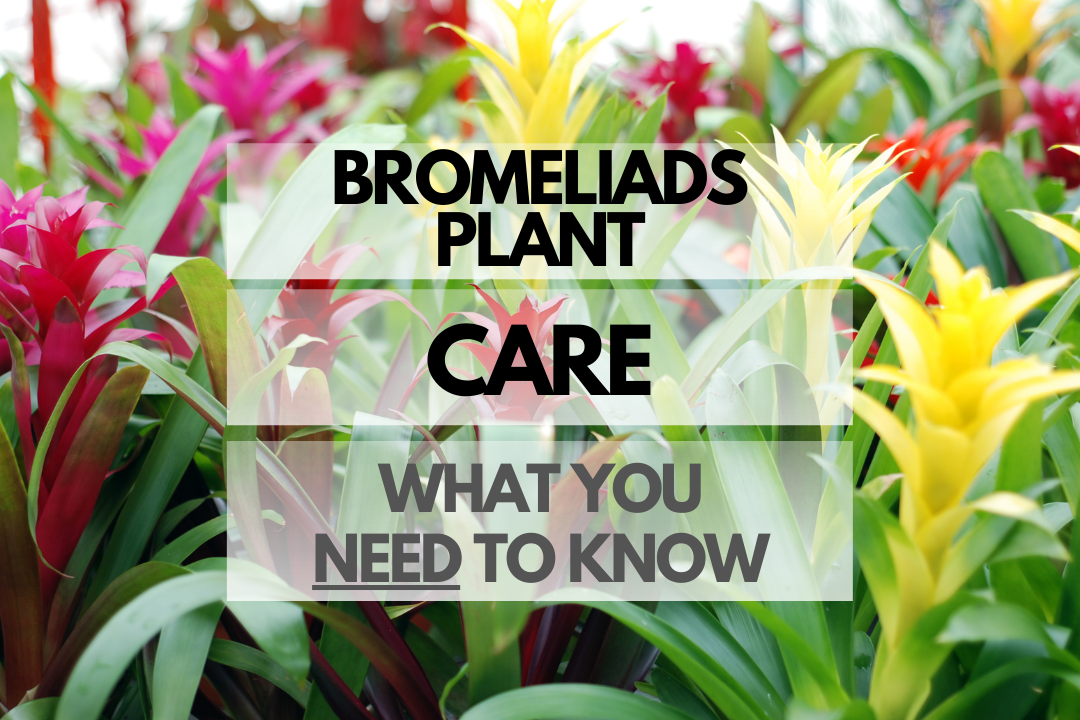Bromeliads Plant Care: What You Need to Know
Bromeliads are a unique and diverse group of plants that offer a stunning array of colors, shapes, and textures. With over 3,000 species, these tropical beauties are perfect for adding a touch of exotic flair to your home or garden. This guide will give you all the essential tips and tricks for successful Bromeliads plant care!
Bromeliads Care Guide
Quick Reference Table: Caring for Bromeliads
| Aspect | Recommendation |
|---|---|
| Light | Bright, indirect light |
| Soil | Well-draining, aerated mix |
| Watering | Keep central tank filled, water soil sparingly |
| Temperature | 60-80°F (15-27°C) |
| Humidity | 50-70% |
| Pot | Breathable pot with drainage holes |
Bromeliads Sunlight: Do They Need It and How Much?
Bromeliads thrive in bright, indirect light. Direct sunlight can scorch their leaves, so it’s best to place them near a window with filtered light, such as a south or east-facing window with sheer curtains. Some species can tolerate lower light levels, but their growth and color may be affected.
Bromeliads Soil Tips
These plants prefer a well-draining, aerated growing medium that allows their roots to breathe. A mix of bark, coconut coir, and perlite is ideal. Avoid using dense, heavy soils, as they can retain too much moisture and cause root rot.
Bromeliads Watering and Frequency
Most Bromeliads have a central tank, or “cup,” that collects water in their natural habitat. Keep this tank filled with water, but make sure to flush it regularly to prevent stagnant water buildup. For the soil, water sparingly, allowing it to dry out slightly between waterings. Overwatering can lead to root rot and other issues.
Pruning Bromeliads Properly
Regular pruning helps keep your Bromeliads looking their best. Remove dead or yellowing leaves by gently pulling them away from the base of the plant. Trim spent flower stalks at the base with clean, sharp scissors or pruning shears. Ensure your tools are sterilized to prevent the spread of diseases.
Optimal Bromeliads Temperature: Can They Tolerate the Cold?
Bromeliads prefer temperatures between 60-80°F (15-27°C). They can tolerate brief periods of cold, but extended exposure to temperatures below 50°F (10°C) can cause damage. If you live in a colder climate, it’s best to bring your Bromeliads indoors during the winter months.
Common Bromeliads Problems
Brown leaf tips
Brown leaf tips are often a sign of low humidity. Increase humidity by placing a tray of water with pebbles near the plant or using a humidifier.
Root rot
Caused by overwatering, root rot is a common issue with Bromeliads. Prevent it by using a well-draining soil mix and watering sparingly.
Pests
Mealybugs, scale, and spider mites can sometimes affect Bromeliads. Treat them with insecticidal soap or neem oil, and maintain good airflow around your plants.
Bromeliads Outdoors vs Indoors
Bromeliads can be grown both indoors and outdoors, depending on the climate and available space. Here are the pros and cons of each:
| Indoors | Outdoors |
|---|---|
| Protection from harsh weather | Greater access to natural sunlight |
| Easier to control humidity | |
| Less risk of pests and diseases | Can create a stunning landscape feature |
| Year-round enjoyment | May require winter protection in colder climates |
Best Pots for Bromeliads
Choose a pot that is breathable and has drainage holes to help prevent root rot. Terracotta pots are an excellent option because they allow air and moisture to pass through their walls. Other materials, such as plastic or ceramic, can also be used, but make sure the pot has proper drainage. Bromeliads generally have shallow root systems, so a wide, shallow pot is preferable to a deep one.
Bromeliads Plant Facts
Bromeliads Plant Benefits
- Air purification: Bromeliads have been found to help remove airborne toxins, improving indoor air quality.
- Low maintenance: These tropical plants are easy to care for and can thrive in a variety of light conditions, making them perfect for beginners.
- Visual appeal: With their stunning colors and unique shapes, Bromeliads make eye-catching additions to any home or garden.
- Humidity tolerance: Bromeliads are well-suited to humid environments, making them great choices for bathrooms or other spaces with high humidity levels.
Growth Rates: How Fast Do They Grow?
Bromeliads have a moderate growth rate, generally reaching maturity within 1-3 years, depending on the species and growing conditions. Some varieties may grow faster, while others may take longer to reach their full size.
Bromeliads Plant Lifespan
Most Bromeliads are perennial plants, meaning they live for several years. However, after they bloom, the main plant will typically start to decline and eventually die, but not before producing offsets, or “pups,” which can be separated and grown into new plants.
Are Bromeliads Plant Safe?
Generally, Bromeliads are considered non-toxic and safe for humans and pets. However, it’s always a good idea to keep plants out of reach of curious pets and children, as ingesting plant material can still cause digestive upset.
Bromeliads Plant Flowers
Bromeliads produce stunning, long-lasting flowers that come in various shapes, sizes, and colors, depending on the species. Flowers can last for several weeks or even months, adding a burst of color to your space.
Bromeliads Plant Types and Varieties
Neoregelia
Neoregelia is known for its vibrant foliage that often features striking patterns and colors. They typically don’t have a prominent flower, as their leaves provide the main visual appeal. Neoregelias are often grown in groups for a more dramatic display.
Guzmania
Guzmania Bromeliads are popular for their showy, brightly-colored flower bracts that rise above the plant’s central rosette. They come in various colors, including red, orange, and yellow, and can add a tropical touch to any space.
Vriesea
Vriesea Bromeliads are known for their spectacular, feather-like flower spikes and intricately patterned leaves. These plants can make a bold statement in your indoor or outdoor garden.
Tillandsia (Air Plants)
Tillandsia, also known as air plants, are unique Bromeliads that grow without soil. They absorb water and nutrients through their leaves and can be mounted on various surfaces, making them perfect for creating living art displays.
Bromeliads Plant Pros and Cons
| Pros | Cons |
|---|---|
| Low maintenance | Can be sensitive to overwatering |
| Air purifying | Some varieties require high humidity |
| Visually appealing | Main plant dies after blooming |
| Non-toxic to pets and humans | Flowers are often short-lived |
Bromeliads Plant Cost
The cost of a Bromeliads plant can vary depending on the size, variety, and source. Smaller plants can be found for as little as $5, while larger or rarer specimens may cost $30 or more.
Where to Buy Bromeliads Plant
Bromeliads can be purchased at local nurseries, garden centers, or online retailers. Specialty Bromeliad nurseries may offer a wider selection of species and varieties.
Is Bromeliads Plant Propagation in Water Possible?
While Bromeliads can be propagated through water, it’s not the most common method. They are typically propagated by removing and planting offsets, or “pups,” that grow around the base of the mother plant.
Additional Resources
- Bromeliad Society International
- Bromeliad Growers & Collectors Facebook Group
- Bromeliads.info
- Book: “Bromeliads for Home and Garden” by Jack Kramer
FAQ for Bromeliads Plant Care
Are Bromeliads toxic to cats?
No, Bromeliads are generally considered non-toxic to cats. However, it’s best to keep plants out of reach, as ingesting any plant material can still cause digestive upset.
Are Bromeliads toxic to dogs?
No, Bromeliads are generally considered non-toxic to dogs. As with cats, it’s best to keep plants out of reach to prevent any potential digestive issues.
Are Bromeliads toxic to kids?
No, Bromeliads are generally considered safe for kids. However, it’s always a good idea to teach children not to touch or ingest plants without adult supervision.
How tall do Bromeliads get?
Bromeliads come in various sizes, with some species growing only a few inches tall, while others can reach several feet in height. The average size is around 1-2 feet tall.
Can Bromeliads live outside?
Yes, many Bromeliads can be grown outdoors in tropical or subtropical climates. They can also be grown as annuals in colder regions during the warmer months.
Are Bromeliads poisonous?
No, Bromeliads are generally considered non-toxic to humans and pets. However, ingesting plant material can still cause digestive upset, so it’s best to keep them out of reach.
How often should I water my Bromeliad?
Watering frequency depends on the specific Bromeliad species and growing conditions. Many Bromeliads prefer to be kept consistently moist but not wet. It’s important to avoid overwatering, as this can lead to root rot.
In conclusion, Bromeliads are versatile, low-maintenance, and visually stunning plants that can be a great addition to your home or garden. With proper care and attention, you can enjoy these tropical beauties for years to come. Happy planting!

